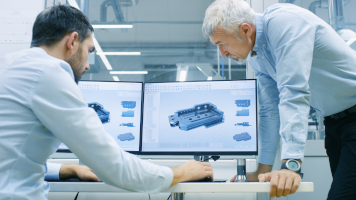Control Systems
Control systems with automatons (PLC) have been extended in a general way in the industry thanks to their versatility. Even simple systems choose this option because of the ability to add functionalities throughout the product life.
Atreydes designs control systems for machines and industrial processes and develop control panels that integrate the necessary components for the movement of machines, combining electrical, hydraulic and pneumatic drives. We also program our own automatons, offering an integrated service in automation.

Input & output (PLC)
Programmable Logic
Programmable logic appears to solve the increased costs of the expansion in automated installations with wired logic due to additions of new components and new functionalities.
New Elements
If we need to expand the possibilities of our installation, all the new elements must be integrated together with the existing ones. It will be necessary to rewire both the new elements and a whole new operating logic.
New Functionalities
If the system is required to work differently from what it was designed for, all wired logic will have to be redesigned. The relationships between the elements which make up the automation are no longer useful and will have to be rebuilt again.
In many cases, components will have to be multiplied. This means, reorganizing the wiring and wiring new elements, which increases time, components and cost.
To solve or reduce these drawbacks, the use of the programmable logic controller (PLC) proposes a change of concept in the control scheme of an automation, using programmed logic that identifies the input devices and output devices and relates them to each other through a modifiable program without having to change the wiring itself. The concepts of inputs and outputs arise here, highlighting the advantages of programmable logic:
Electrical signal that reflects the state of a device external to the PLC. This state is one of the conditions for the evolution of the automation.
Man-machine control drives.
Sensors.
Status indicator signals from drives such as relays, contactors, speed controllers, temperature regulators ...
Electrical signal that reflects the result of the combinations processed by the automaton (PLC) according to the relationships programmed in it. That is to say, according to a software.
Relays, contactors.
Electronic devices such as speed controller.
Signaling devices.
Solenoid valves.
Wiring is not dependent on the function of each device.
Wiring is faster and clearer.
The number of auxiliary control devices is reduced.
To add new operating modes, it is only necessary to modify the program. No rewiring is required.
To set new operating conditions it is only necessary to apply them in the software and, in any case, to add new devices to the controller without the need to rewire the existing devices.
If the operation changes completely, it will be enough to create a new program and add or remove components, without the need to rewire the whole panel.
The PLC has developed a series of functions, timers, counters, which in wired logic would mean adding and wiring new devices to integrate their function in the automation.
At the same time, the PLC increases the control possibilities with the integrated treatment of more complex signals such as analog, PID control... as well as communication systems, SCADA control, operator panels... which are totally unthinkable in wired logic.
Our Added Value
Our high added value offers the best solution for our customers, combining different technical areas, computer applications and technologies to optimize their final products.
In the last years, collaborative robotics have started to take an important role in industrial processes, substituting to or collaborating with operator increasing the speed, quality, accuracy and safety of manufacturing tasks.






